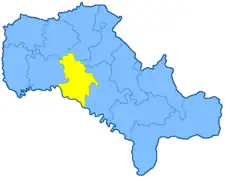Mogilev uezd
Могилевскій уѣздъ | |
|---|---|
 Coat of arms | |
 Location in the Podolia Governorate | |
| Country | Russian Empire |
| Krai | Southwestern |
| Governorate | Podolia |
| Established | 1795 |
| Abolished | 1923 |
| Capital | Mogilev-Podolsky |
| Area | |
| • Total | 2,746.14 km2 (1,060.29 sq mi) |
| Population (1897) | |
| • Total | 227,672 |
| • Density | 83/km2 (210/sq mi) |
| • Urban | 14.19% |
| • Rural | 85.81% |
The Mogilev uezd[lower-alpha 1] was a county (uezd) of the Podolia Governorate of the Russian Empire. It bordered the Letichev and Litin uezds to the north, the Yampol uezd to the east, the Soroka uezd to the south, and the Ushitsa uezd to the west. The administrative centre of the county was Mogilev-Podolsky (modern-day Mohyliv-Podilskyi). The uezd included most of Mohyliv-Podilskyi and Zhmerynka Raions of Ukraine.
Administrative divisions
The subcounties (volosts) of the Mogilev uezd in 1912 were as follows:[1]
| Name | Name in Russian | Capital |
|---|---|---|
| Bronitsa volost | Броницкая волость | Bronitsa |
| Vendychany volost | Вендычанская волость | Vendychany |
| Kopai-Gorod volost | Копай-Городская волость | Kopai-Gorod |
| Kotyuzhany volost | Котюжанская волость | Vysshiy Olchedaev |
| Kukavka volost | Кукавская волость | Kukavka |
| Luchinets volost | Лучинецкая волость | Luchinets |
| Maryanovka volost | Марьяновская волость | Maryanovka |
| Ozarintsy volost | Озаринецкая волость | Ozarintsy |
| Belyany-Shargorod volost | Сербянская волость | Belyany-Shargorod |
| Snitkov volost | Снитковская волость | Snikov |
| Tereshki volost | Терешковская волость | Tereshki |
| Khonkovtsy volost | Хоньковская волость | Khonkovtsy |
| Shargorod volost | Шаргородская волость | Shargorod |
| Yaryshev volost | Ярышевская волость | Yaryshev |
Demographics
At the time of the Russian Empire Census on 28 January [O.S. 15 January] 1897, the Mogilev uezd had a population of 227,672, including 112,856 men and 114,816 women. The majority of the population indicated Little Russian[lower-alpha 2] to be their mother tongue, with a significant Jewish speaking minority.[4]
| Language | Native speakers | Percentage |
|---|---|---|
| Little Russian[lower-alpha 2] | 183,353 | 80.53 |
| Jewish | 33,036 | 14.51 |
| Great Russian[lower-alpha 2] | 6,377 | 2.80 |
| Polish | 4,249 | 1.87 |
| German | 175 | 0.08 |
| Tatar | 121 | 0.05 |
| Czech | 101 | 0.04 |
| White Russian[lower-alpha 2] | 98 | 0.04 |
| Cheremis | 40 | 0.02 |
| French | 25 | 0.01 |
| Romanian | 23 | 0.01 |
| Bashkir | 19 | 0.01 |
| Cheremis | 18 | 0.01 |
| Latvian | 3 | 0.00 |
| Gipsy | 2 | 0.00 |
| Other | 32 | 0.01 |
| Total | 227,672 | 100.00 |
Notes
- ↑
- 1 2 3 4 Prior to 1918, the Imperial Russian government classified Russians as the Great Russians, Ukrainians as the Little Russians, and Belarusians as the White Russians. After the creation of the Ukrainian People's Republic in 1918, the Little Russians identified themselves as "Ukrainian".[2] Also, the Belarusian Democratic Republic which the White Russians identified themselves as "Belarusian".[3]
References
- ↑ Волостныя, станичныя, сельския, гминныя правления и управления, а также полицейские станы всей России с обозначением места их нахождения [Volostny, stanichnaya, rural, communes of government and administration, as well as police camps throughout Russia with the designation of their location]. Kiev: Izd-vo T-va L. M. Fish. 1913. p. 162. Archived from the original on 2022-12-11.
- ↑ Hamm, Michael F. (2014). Kiev: A Portrait, 1800–1917. Princeton University Press. p. 83. ISBN 978-1-4008-5151-5.
- ↑ Fortson IV, Benjamin W. (2011). Indo-European Language and Culture: An Introduction. John Wiley & Sons. p. 429. ISBN 978-1-4443-5968-8.
- 1 2 "Демоскоп Weekly - Приложение. Справочник статистических показателей". www.demoscope.ru. Retrieved 2019-12-19.